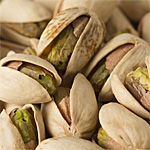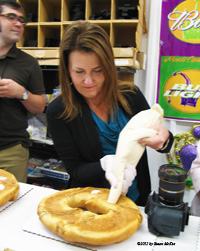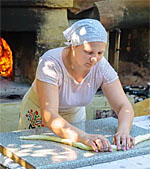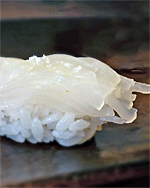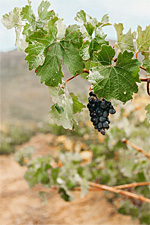Caribbean Shellfish
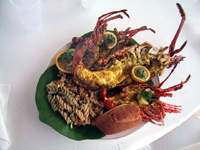 Crustaceans at Scilly Cay (Photo by Susan McKee)
Crustaceans at Scilly Cay (Photo by Susan McKee)The Road Trip Foodie
When I first went to Anguilla, I had no idea that there were different species of lobster. Most of my experience was with those snappy Maine crustaceans, but that’s not what you find in the Caribbean.
North American fishermen haul in lobsters with big claws from the briny deep. In the Caribbean, the catch is the Spiny Lobster. Both kinds are crawling decapod crustaceans. They are cold-blooded and have hard exoskeletons, five pairs of jointed walking legs, segmented bodies, sensory antennae, tail fans and compound eyes on stalks. They can walk forwards, but if they want to move fast, they curl their segmented tails under their bodies to swim backward.
All my life, I’d been eating the American lobster — Homarus americanus — with its enlarged claws or pincers. On Anguilla, I came face to face with something new — Panulirus argus. This species, the Spiny Lobster (also known as the Caribbean or Rock Lobster) has two ordinary front legs where the claws would be. Its carapace is marked with bright green, blue and yellow spots on an orange or brown shell.
The Spiny Lobster defends itself by using its two long, thorny antennae as whips, and adds to its menacing appearance with rows of short, sharp spines along the length of its tail and body. These crustaceans also have a unique ability to make scary noises by drawing their leathery plectra (protrusions at the base of each antenna) across scaly ridges below their eyes. Anguillans told me it sounds like the screech of a violin bow pulling across a badly tuned string.
Spiny lobsters are found in relatively shallow water in the rocks and coral reefs. They start life in a cluster of 10-20,000 eggs beneath the tail of one female – as was the case in the two who escaped the fire on Scilly Cay that day. When the eggs are ready to hatch, mom releases them in the open sea. Only a handful make it through the perilous journey to maturity, with the lucky ones who escape predators and fishermen growing to about 20 inches long and weighing about 10 pounds.
In fact, crustaceans with child are spared: females with eggs are tossed back to continue replenishing the species. That means, you can’t always get what you want, even in paradise. There I was, sitting on Scilly Cay, anticipating my barbecue-grilled lobster, when the bad news arrived. Four patrons had ordered Caribbean Spiny Lobster for lunch. Four critters had been captured – but the two females were loaded with eggs and had to be released. The equitable solution: each of us would get ½ of a lobster, plus a grilled crayfish.
Of course, I was thinking I’d end up with a mini Missouri crawdad or a slightly heftier Louisiana crawfish, but those are the wimpy freshwater cousins of lobsters. Caribbean crayfish are as large as — as lobsters. Seems there are more than 500 species of crayfish found worldwide. The ones I know best, the American dwarf crayfish, are only about 1-1/3 inches long. The largest, the Tasmanian, can be eight pounds. On Anguilla, the crayfish are somewhere in between.
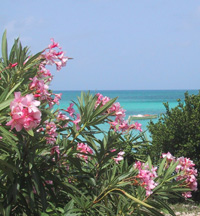 Rendezvous Bay (Photo by Susan McKee)
Rendezvous Bay (Photo by Susan McKee)When my plate arrived with crustaceans hot from the oil-drum grill on the beach, I knew I had a feast at hand. Plunging in, I managed to demolish everything (including the pasta salad, fresh fruit and grilled bread) washing it all down with a rum punch that deserves its name and an ice water chaser. (I’d been warned about the potency of the punch, especially on a hot summer’s afternoon, so I stuck to one serving.)
As I ate, I tried to puzzle out the barbecue sauce – I think I detected hot peppers, a trace of mustard, some peanuts perhaps and a touch of sugar from an orange marmalade. Gorgeous wasn’t talking.
Outlanders often come to Anguilla looking for lobster. A recent poll on an island discussion forum frequented by locals and visitors concluded that the favorite dish for “breakfast, lunch or dinner” was lobster, with crayfish second.
It doesn’t seem to matter how the crustaceans are prepared. A posting on another Anguillan on-line forum asking for the “best lobster dish” brought more than two dozen suggestions, ranging from Caribbean-grilled with a honey-lemon-rum glaze to the continental combination of lobster ravioli served with melted butter sauce and chunks of lobster.
I just had a few days on Anguilla, and I wanted to sample as many of these sea creatures as I could.
This is a small island – about sixteen miles long and three miles across – with a year-round population of about 12,000. Development is tightly controlled on this tiny outpost of the British Empire. The Department of Physical Planning is determined to have “orderly and sustainable development of Anguilla’s natural resources and infrastructure.”
One of the results is Anguilla’s unhurried pace. There’s no rush to do anything here on what’s probably the last unspoiled island in the Caribbean. The airport can handle only small airplanes, so there aren’t any big tour groups. There’s no seaport capable of handling a cruise ship. There are no shopping malls, no thousand-room hotels, no casinos and no fast food restaurants.
But, with more than seventy dining options, it’s said there are more gourmet restaurants per acre on the island of Anguilla than on the island of Manhattan. In any case, slow food is nothing new here. Expect to linger over your meal, enjoying every bite. I wanted most of my leisurely bites to be shellfish.
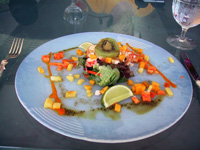
Lobster Salad at Altamer (Photo by Susan McKee)
At Pimm’s, one of the restaurants at Cap Juluca, I started with an Anguilla Crayfish Dumpling nestled alongside carrots, and enoki mushrooms in hon dashi broth before plunging into my main course. I selected the island’s other signature seafood, red snapper, this time steamed and served on a bed of curried cabbage and jasmine-scented rice with a sizzling oriental sauce flavored with teriyaki and soy. The setting was perfect for fish – if my table had been any closer to the edge of the porch, I would have been in the Caribbean myself.
Dinner took almost three hours, but – what the heck! There was a full moon reflected in the water, and the canvas-draped ceilings rippled in the sea breeze. Fans whirled noiselessly overhead as I looked around the room. I was alone among honeymoon couples with eyes only for each other.
My last dinner on the island was at Cedar Grove Restaurant in the Rendezvous Bay Hotel. The Anguilla Lobster Cakes were a delectable finale to my seafood feeding frenzy.


